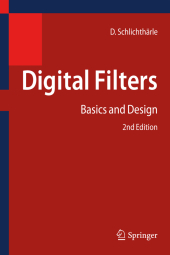 Neuerscheinungen 2014Stand: 2020-02-01 |
Schnellsuche
ISBN/Stichwort/Autor
|
Herderstraße 10
10625 Berlin
Tel.: 030 315 714 16
Fax 030 315 714 14
info@buchspektrum.de |

Dietrich Schlichthärle
Digital Filters
Basics and Design
2. Aufl. 2014. xv, 527 S. 235 mm
Verlag/Jahr: SPRINGER, BERLIN; SPRINGER BERLIN HEIDELBERG 2014
ISBN: 3-642-43285-9 (3642432859)
Neue ISBN: 978-3-642-43285-9 (9783642432859)
Preis und Lieferzeit: Bitte klicken
The second, strongly enlarged edition of this textbook gives a substantial insight into the characteristics and the design of digital filters. It includes an introduction to the theory of continuous-time systems and the design methods for analog filters.
The second, strongly enlarged edition of the textbook gives a substantial insight into the characteristics and the design of digital filters. It briefly introduces to the theory of continuous-time systems and the design methods for analog filters. Time-discrete systems, the basic structures of digital filters, sampling theorem, and the design of IIR filters are widely discussed. The author devotes important parts to the design of non-recursive filters and the effects of finite register length. The explanation of techniques like oversampling and noise shaping conclude the book.
The author has substantially updated all chapters and added some important topics like Allpass filters. With an emphasize put on the practical implementation of theoretical concepts, the book is a reference for advanced students as well as practicing engineers.
Continuous-Time Systems.- Analog Filters.- Discrete-Time Systems.- Sampling Theorem.-
Filter Structures.- Design of IIR Filters.- Design of FIR Filters.- Effects of Finite Register Length.- Oversampling and Noise Shaping.- Appendix.- Index.
From the reviews of the second edition:
"This second edition of the textbook gives a comprehensive insight into the characteristics and the design of digital filters. ... The text is written very clearly and does not require more than the standard mathematical background material. Numerous worked-out examples and a large number of exercises are included in the book. The book may be very useful for students, postgraduate students, engineers and scientists who are studying and designing digital filters. It is suitable for self-studying." (Mikhail P. Moklyachuk, Zentralblatt MATH, Vol. 1231, 2012)


